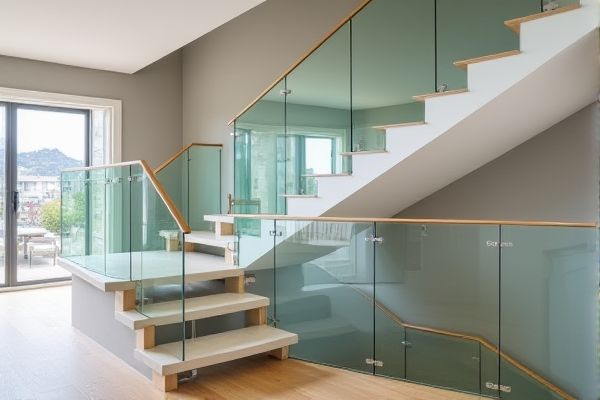
Glass balustrades offer superior clarity and durability, providing a sleek, modern look with excellent weather resistance, while acrylic balustrades are lightweight, more affordable, and easier to install but may scratch and yellow over time. Discover which option best suits Your design needs and budget by exploring the detailed comparison in the rest of this article.
Table of Comparison
| Feature | Glass Balustrade | Acrylic Balustrade |
|---|---|---|
| Material | Tempered or laminated glass | High-impact acrylic (PMMA) |
| Transparency | Crystal clear, high optical clarity | Clear but can yellow over time |
| Durability | Highly scratch-resistant, weatherproof | Scratch-prone, less UV resistant |
| Weight | Heavier, requires sturdy framing | Lightweight, easier to install |
| Maintenance | Easy to clean, resists stains | Needs frequent polishing, can discolor |
| Safety | Breaks into small, less harmful pieces | Shatters less but can crack under impact |
| Cost | Moderate to high | Generally lower |
| Applications | Modern architecture, pool fencing, balconies | Indoor partitions, lightweight fencing |
Introduction to Glass and Acrylic Balustrades
Glass balustrades offer a sleek, modern aesthetic with high transparency and superior durability, making them ideal for both indoor and outdoor applications. Acrylic balustrades provide a lightweight, cost-effective alternative with exceptional impact resistance, though they may scratch more easily and yellow over time. Both options enhance safety and visibility while catering to different design preferences and budget considerations.
Material Composition and Properties
Glass balustrades are made from tempered or laminated glass, providing high-strength, durability, and excellent transparency with resistance to scratches and weathering. Acrylic balustrades, composed of polymethyl methacrylate (PMMA), offer lightweight properties and high impact resistance but are more prone to surface scratches and UV-induced yellowing over time. Both materials provide aesthetic appeal and safety, yet glass offers superior clarity and long-term resistance, while acrylic excels in flexibility and ease of installation.
Aesthetic Differences
Glass balustrades offer a sleek, modern aesthetic with crystal-clear transparency that enhances natural light and provides an unobstructed view, making spaces appear larger and more open. Acrylic balustrades, while available in various tints and finishes, often have a slightly less polished appearance and may show scratches over time, impacting long-term visual appeal. Your choice between glass and acrylic will significantly influence the overall elegance and brightness of your interior or exterior design.
Strength and Durability
Glass balustrades offer superior strength and durability due to tempered or laminated safety glass, which resists impact and weathering while maintaining clarity over time. Acrylic balustrades, though lighter and more flexible, tend to be more prone to scratches, discoloration, and UV damage, potentially compromising their long-term appearance and performance. Choosing a glass balustrade enhances the structural integrity of your railing system with minimal maintenance required.
Safety Considerations
Glass balustrades offer superior impact resistance and are typically made from toughened or laminated glass, making them highly durable and less prone to shattering. Acrylic balustrades, while lighter and more flexible, are more susceptible to scratches and cracks under force, potentially compromising safety over time. Your choice should weigh the enhanced strength and clear visibility of glass against the lightweight and cost-effective nature of acrylic for optimal safety performance.
Maintenance Requirements
Glass balustrades require regular cleaning with non-abrasive glass cleaners to maintain clarity and prevent water spots, with occasional inspections for chips or cracks to ensure safety. Acrylic balustrades demand more frequent cleaning due to their susceptibility to scratches and UV yellowing, using mild soap and water to avoid surface damage. Both materials benefit from routine maintenance, but glass balustrades generally offer greater durability and longer-lasting aesthetic appeal with lower upkeep.
Cost Comparison
Glass balustrades typically have a higher upfront cost due to the price of tempered or laminated safety glass and the need for specialized installation. Acrylic balustrades offer a more budget-friendly alternative with lower material and installation expenses, though they may require more frequent maintenance or replacement over time. When factoring in durability and lifespan, glass balustrades often present better long-term value despite the initial investment.
Installation Process
Glass balustrades require precise handling and professional installation due to their heavy weight and fragility, often involving custom cutting and secure anchoring to ensure stability and safety. Acrylic balustrades offer a lighter, more flexible alternative, allowing for easier DIY installation and simpler mounting options without specialized tools. Choosing between the two depends on your preference for durability and the complexity of the installation process.
Environmental Impact
Glass balustrades offer superior environmental benefits due to their recyclability and longer lifespan, reducing waste over time compared to acrylic balustrades. Acrylic balustrades, derived from petroleum-based products, contribute more significantly to environmental pollution and have a shorter lifecycle, leading to more frequent replacements. Choosing a glass balustrade aligns with sustainable building practices and minimizes your ecological footprint.
Choosing the Right Balustrade for Your Project
Glass balustrades offer superior clarity, durability, and a modern aesthetic, making them ideal for contemporary architectural projects requiring both safety and unobstructed views. Acrylic balustrades provide a lightweight, cost-effective alternative with enhanced impact resistance, suitable for budget-conscious projects or areas prone to heavy wear. Evaluating factors such as environmental exposure, maintenance requirements, and visual preferences ensures selecting the optimal balustrade material tailored to the specific demands of your project.
 homyna.com
homyna.com